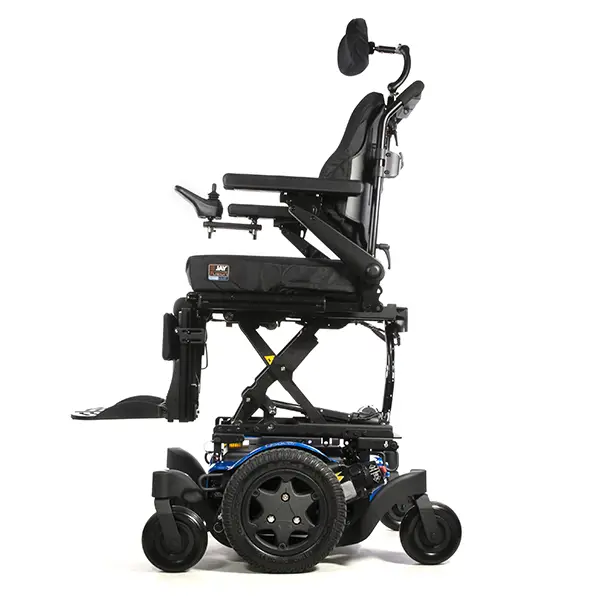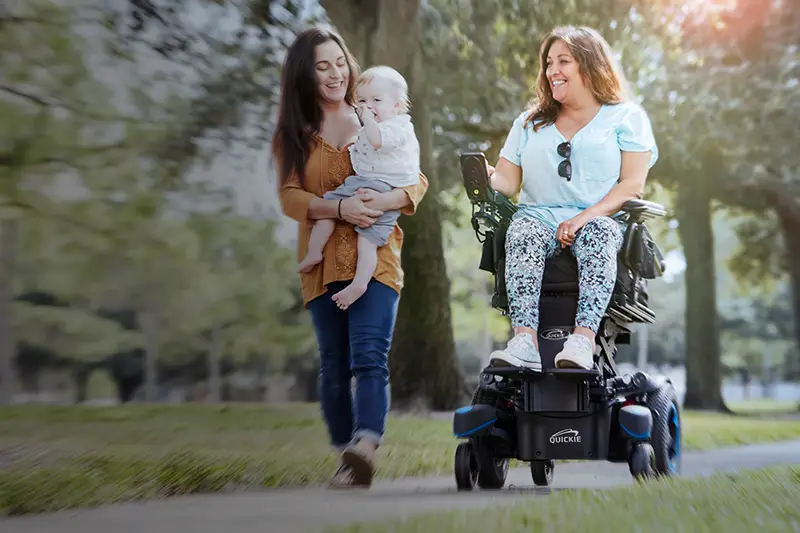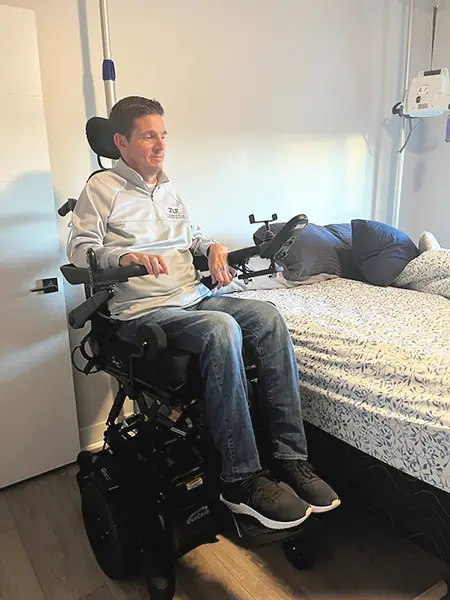Benefits of Power Seat Elevation
Power seat elevation, or a "seat elevator," is an optional function available on a power wheelchair that is beneficial for many power wheelchair riders. It allows the person to remain supported in a seated position and use their controls to raise the vertical height of their seating system on the power chair base. The application and benefits are well documented and supported by RESNA and many other groups in the Complex Rehabilitation Technology industry.

As a review, power seat elevation improves:
- Ability to reach items that may otherwise be too high
- Ability to do a sit-stand transfer if weakness prevents the client from standing from their typical seated height
- Ergonomics at a desk
- Reach for clients with shoulder weakness, pain, or limited range of motion who have difficulty raising their arms
- Safety while using a stovetop
- Access to a taller table for a meal or to a countertop for meal prep
- Visual line-of-sight of the environment by having the option to sit higher
- Visibility in the community by increasing seated height
- Caregiver lifting biomechanics during transfers
- Access for caregivers to remove/place a sling for a mechanical lift
- Safety, efficiency, and biomechanics of lateral transfers by being able to position the wheelchair higher than the surface being transferred to
- And more!
Working with Medicare
In 2023, Medicare announced that they will cover a power seat elevator on a power wheelchair for clients who perform sit-stand transfers, stand-pivot transfers, lateral seated transfers, and dependent transfers (with or without a lift). Per criteria, transfers can be performed with or without caregiver assistance and with or without an assistive device. In addition to transfers, Medicare also considers reaching during Mobility-Related Activities of Daily Living (MRADLs) in their coverage criteria. The National Coverage Determination1 states:
Power seat elevation equipment is reasonable and necessary for individuals using complex rehabilitative power-driven wheelchairs, when the following conditions are met:
- The individual has undergone a specialty evaluation that confirms the individual's ability to safely operate the seat elevation equipment in the home. This evaluation must be performed by a licensed/certified medical professional such as a physical therapist (PT), occupational therapist (OT), or other practitioner, who has specific training and experience in rehabilitation wheelchair evaluations; and,
- At least one of the following apply:
- The individual performs weight bearing transfers to/from the power wheelchair while in the home, using either their upper extremities during a non-level (uneven) sitting transfer and/or their lower extremities during a sit to stand transfer. Transfers may be accomplished with or without caregiver assistance and/or the use of assistive equipment (e.g. sliding board, cane, crutch, walker, etc.); or,
- The individual requires a non-weight bearing transfer (e.g. a dependent transfer) to/from the power wheelchair while in the home. Transfers may be accomplished with or without a floor or mounted lift; or,
- The individual performs reaching from the power wheelchair to complete one or more mobility related activities of daily living (MRDALs) such as toileting, feeding, dressing, grooming and bathing in customary locations within the home. MRADLs may be accomplished with or without caregiver assistance and/or the use of assistive equipment.

As you can see, by asking questions about transfer method and/or ability to complete MRADLs in the home, rationale for power seat elevation can be documented and it is an obtainable power seat function for clients with Medicare. The functional and clinical benefits should be readily considered and discussed during a power wheelchair evaluation.
Confused about dependent transfers and how power seat elevation benefits the patient?
We know that justification should always be focused on the benefits to the patient, so how does power seat elevation benefit the patient during a dependent transfer with a lift?
The individual's power wheelchair was configured with seating specific to their posture, positioning, and skin protection needs. Ideally, they are not sitting on their sling all day. Power seat elevation ensures that the client can be positioned at an appropriate height for a caregiver to support the individual and facilitate the necessary weight shifts that allow a sling to be safely removed from under the client. By adjusting the seat height appropriately for varying caregiver heights, the client and their skin are protected as the sling is removed.
Working with Commercial Insurances and State Medicaid Plans
We've talked about Medicare, but every commercial insurance has different medical policies that dictate their coverage and how they determine medical necessity for power seat elevation. While many follow the guidelines that Medicare sets, there can be variations in eligibility requirements by insurance and by state. The best way to learn about specific coverage criteria is to read the medical policy in place by the client's insurance.
How do you find a medical policy?
Use the resources available to you. You can ask your supplier ahead of time or try searching the internet with: the insurance carrier name + "medical policy" + "power seat elevation". It is often outlined with the coverage determination for power wheelchairs.
Tips for Documentation
Here are some tips for documentation when you are seeking approval of power seat elevation:
Know the patient's funding source
As we discussed above, it is helpful to learn how the client's insurance determines eligibility for power seat elevation. Knowing this is a starting point for understanding which key information to include in your subjective and objective assessment and you can start building clear and to-the-point justification. Not only will the justification be more efficient when you understand their funding, but you can also set appropriate expectations with the patient about the process of obtaining power seat elevation if a denial and subsequent appeal might be anticipated.
Knowing the insurance policy also allows you to word your justification in a way consistent with the policy and without unneeded details. Many reviewers are looking for key terms or comparing the justification to the medical policy, so knowledge of what it states can go a long way in communicating effectively.
Self-pay
Keep in mind that if a patient's use of power seat elevation does not meet the criteria for coverage set by their insurance, they may have the option to use an alternative source of funding available to them or to self-pay. With some payers, a denial has to be in place for the client to self-pay, so don't exclude power seat elevation from the conversation at the evaluation or from the prescribed configuration based on known insurance coverage limitations.
Ask questions to understand how power seat elevation would benefit your patient
Ask specifically about transfers, ability to reach items in their home, community, or workplace, and their inability to complete MRADLs. As you find situations where seat elevation is or will be used, think about how the patient's impairments contribute to difficulty with these tasks from a static seat height to start to build your justification.
General questions
Here are some questions that can help guide the conversation:
- Do you currently have a power wheelchair (PWC) with power seat elevation?
- Do you have difficulty, or need assistance to transfer from a PWC to a surface (bed, toilet, shower chair, car/van seat, etc.) that is higher than the PWC seat?
- Do you have difficulty, or need assistance to reach high enough to access one or more of the following areas at home, school, work, or community? Indicate all that apply:
- Dresser drawers; clothes rod; washer or dryer
- Medicine cabinet; bathroom sink/faucet; mirror; shower head/faucet
- Freezer/refrigerator; oven/stove (including light/exhaust fan switches); microwave; cupboards/shelves; counter; sink/faucet; disposal switch
- Light switches; thermostat; fire alarm; wall phone; speaker; door eye hole/viewer; doorbell; elevator buttons
- Other
- Do you have difficulty seeing where you are going, moving through crowds, or safely crossing the street from a low (standard) seat height?
- Do you experience neck pain, or have difficulty seeing or hearing those standing nearby when seated in a PWC?
- Do you experience any difficulty or pain sitting in a PWC as a result of looking up or reaching overhead?
- Would a power seat that elevates 12" and allows you to drive in the elevated position at walking speed be of benefit to carrying out your daily living routines?

Remember that most commercial plans and Medicare do not consider activities in the community (including transportation) to be medically necessary, so focusing your questions in utilization in the home for transfers and MRADLs will be the most valuable for your documentation with those funding sources.
Conversely, Medicaid plans, waivers, and grant sources may consider use outside the home as medically necessary, so questions related to the community, school, or workplace are still valuable. This is especially true with clients who complete dependent transfers and have caregiver assistance for MRADLs but still would like to pursue power seat elevation. Getting the big picture of how power seat elevation can improve your client's quality of life and documenting all areas where it will benefit is important, especially when the final funding could end up outside of Medicare or a commercial plan.
Transfer-specific questions
Specific to transfers, Julie Piriano has outlined the following clinical considerations2:
Does adjusting the height of the seat prior to the transfer:
- Make the transfer safer?
- Make it more efficient?
- Increase independence with the transfer?
- Reduce risk of repetitive strain injury to the upper extremities, especially if they are already compromised?
- Reduce risk of fall or injury?

Thoroughly and accurately document your objective assessment measures in areas that support the individual's need for power seat elevation
A clear picture of the client's impairments should support the request for power seat elevation for the reviewer. As you write the justification, ensure that the objective measures you document are consistent with your rationale.
Examples of objective measurements that need to be consistent with justification for power seat elevation:
- Lower extremity and upper extremity strength
- Upper extremity range of motion
- Transfer status
- Seated/standing static and dynamic balance
- Pain (location and severity)
When you know you are working with a challenging funding source or if you have received a denial and are working through an appeal, you may also choose to document environmental measurements or comparison measurements. These may be things such as:
- What is the client's safe and pain-free vertical reach and how high are varying items they need to perform MRADLs in customary locations in their home?
- What is the client's seat height and what height are specific surfaces in their home that they transfer to?
- How much assistance does the client need to transfer from a non-elevated seat height and at what height are they able to demonstrate more independence, participation, safety, or efficiency?
Use available resources
The Wheeled Mobility Seating Evaluation Form (WMSE) is acceptable to submit in place of a Letter of Medical Necessity for many insurances. It is a thorough document that includes physical evaluation findings, recommended items, and has checkbox-style justification options. There are sections to indicate ability to safely reach (p. 2), goals of power seat elevation (p. 10), and the justification for power seat elevation (p. 13). You can use the WMSE fully or as a reference and guide to assist you with your documentation.
Summary
Power seat elevation is a seating function that can enhance independence, maximize function, increase safety, and protect against pain and injury for the power wheelchair rider. Documentation that includes relevant and applicable subjective and objective assessment findings is essential for justifying your patient's need for power seat elevation and contributes to a successful outcome.
References
- https://www.cms.gov/medicare-coverage-database/view/ncd.aspx?ncdid=376
- Piriano, J. and Osborn, M. (2023 November 14). Power Seat Elevation - Examining Opportunities. International Registry of Rehabilitation Technology Suppliers. https://nrrts.org/courses/11-14-23-power-seat-elevation-examining-the-opportunities-julie-piriano-pt-atp-sms-mike-osborn-atp-crts/
Christy Natale, DPT, ATP/SMS, has a dual background in the rehabilitation industry, starting her career as a pediatric Physical Therapist before transitioning to the role of Assistive Technology Professional for a supplier where she worked with a variety of ages and diagnoses. She earned her Doctorate in Physical Therapy from Pacific University in 2009 and has a combined 15 years of experience providing customized seating, positioning, and mobility solutions tailored to the needs and goals of her clients. Her specialties include pediatric positioning and mobility, alternative drive controls, power wheelchair programming, and sleep positioning in the scope of 24-hour postural care.